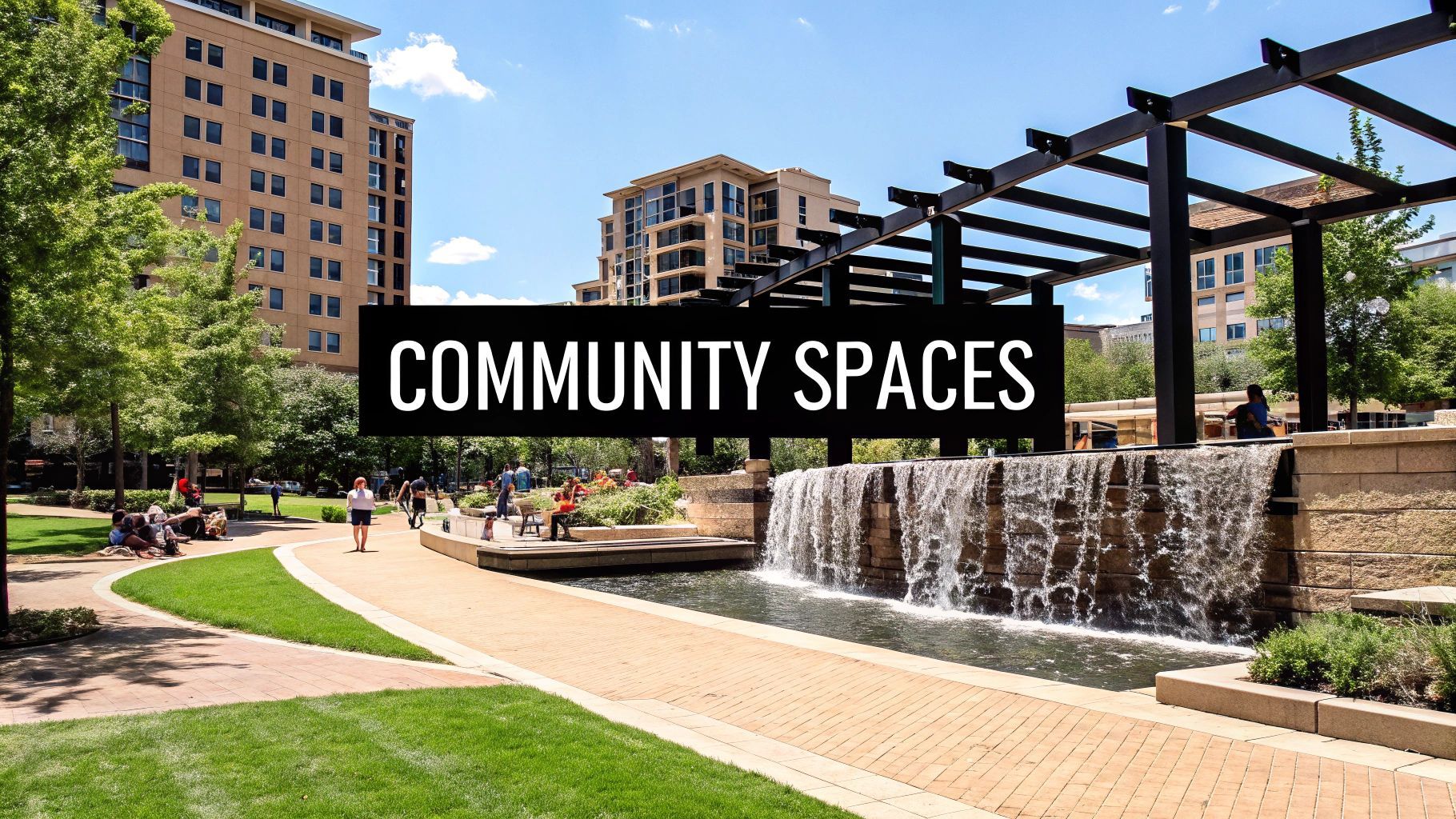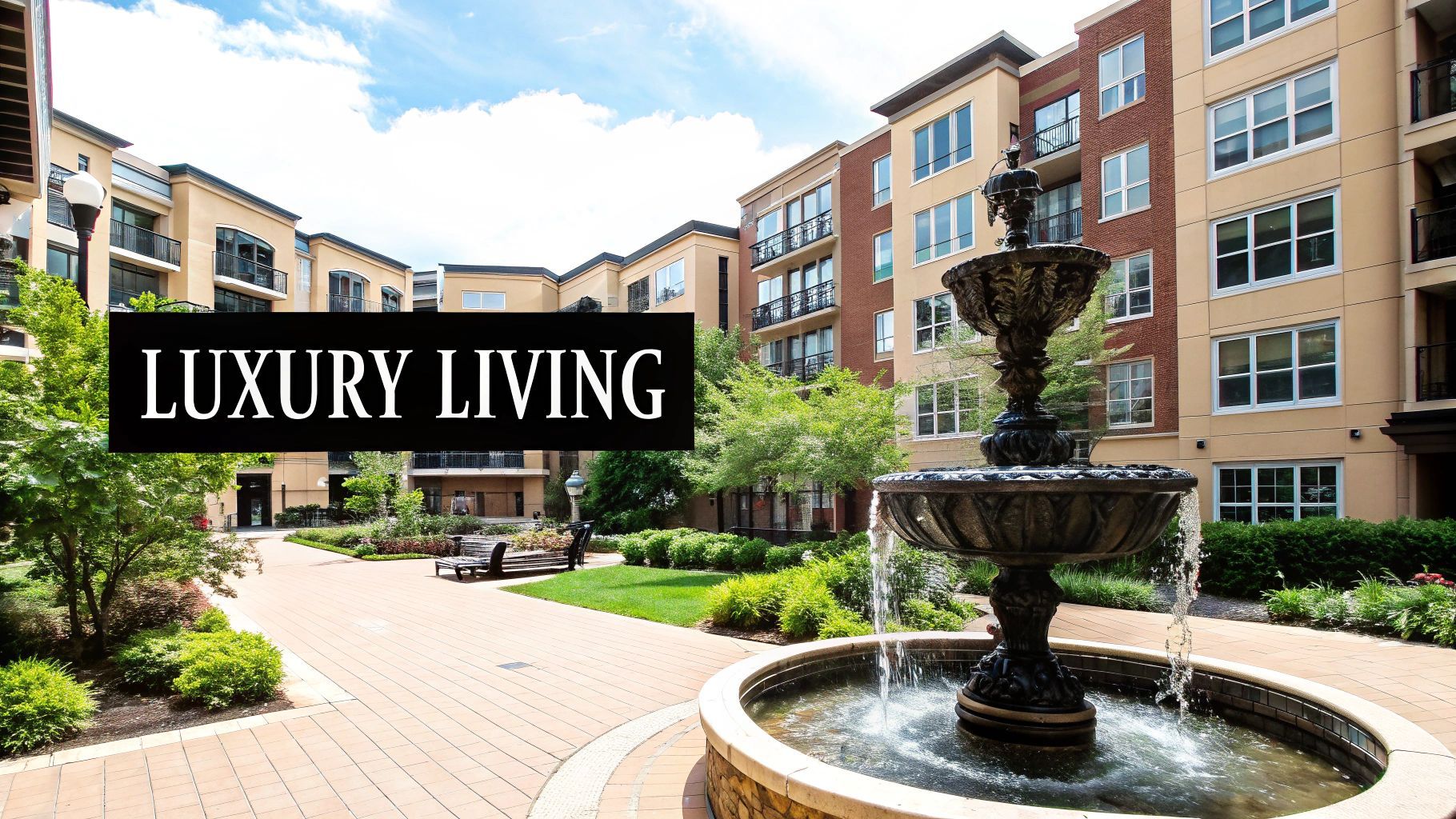Real Estate Waterfall Structure: A Step-by-Step Guide to Modern Profit Distribution
Real Estate Waterfall Structure: A Step-by-Step Guide to Modern Profit Distribution
Master real estate waterfall structures with proven strategies from industry experts. Learn how successful firms structure preferred returns, IRR hurdles, and profit-sharing to maximize investment outcomes.
Domingo Valadez
Dec 30, 2024
Blog
Understanding Modern Waterfall Structures
At their core, real estate waterfall structures determine how investment returns flow between partners. These frameworks establish clear rules for distributing profits between investors and project sponsors, helping create alignment and manage risk effectively. Getting the structure right is essential for attracting investors and ensuring successful project outcomes.
Deconstructing the Waterfall: Key Components and Their Roles
Picture a waterfall structure as a series of pools, each representing different return thresholds that must be met in sequence. The first priority is returning initial capital to limited partners (LPs) - this "Return of Capital" ensures investors get their principal back before any profit sharing begins. This foundational element gives investors confidence their original investment is protected.
After returning initial capital, most structures include a "Preferred Return" - typically 5-8% annually that investors receive before sponsors participate in profits. For example, on a $100,000 investment, an investor would receive $5,000-$8,000 in preferred returns annually before the sponsor sees any upside. This creates a baseline return expectation and helps offset investment risk.
Beyond the Basics: IRR Hurdles and Promote Structures
Once preferred returns are met, additional return thresholds tied to Internal Rate of Return (IRR) come into play. These performance hurdles determine how profits are split between parties. For instance, up to a 10% IRR, profits might split 80/20 in favor of investors. Above that threshold, the split may shift to 70/30 or 60/40 to reward sponsors for strong results. This tiered "promote" structure motivates sponsors while protecting investor interests.
Navigating Complexities: Catch-Up Provisions and Multi-Tiered Systems
More advanced waterfalls may include catch-up provisions allowing sponsors to receive a larger share of profits after certain milestones. For example, once preferred returns are met, sponsors might get 100% of distributions until reaching their target promote percentage. This rewards strong performance without compromising investor protections.
Many larger projects use multi-tiered structures with several return hurdles and changing profit splits. While adding complexity, this approach enables more precise alignment of incentives. The key is striking the right balance - structures should be thorough but still clear and manageable. Open communication between all parties is essential. When properly designed, waterfall structures create the foundation for successful real estate investments built on trust and shared goals.
Mastering Preferred Returns

Preferred returns form a critical part of real estate waterfall distributions by offering key protections for investors. This mechanism ensures investors receive a specified return rate before sponsors can share in profits. Far more than just profit distribution, preferred returns help build trust between partners and create proper incentives from day one. Understanding how to structure them effectively is crucial for any sponsor looking to raise capital successfully.
Determining the Optimal Preferred Return Rate
Most real estate investments set preferred returns between 5% and 8% per year, but finding the right rate requires careful consideration of multiple factors. The appropriate rate depends on project-specific elements like risk level, current interest rates in the market, and the sponsor's past performance. For instance, projects with higher uncertainty may warrant offering investors a higher preferred return as compensation. Getting this balance right is essential for creating a sustainable waterfall structure.
Implementing Effective Catch-Up Provisions
Preferred returns take priority in distributions after investors receive their initial capital back. Many deals include catch-up provisions that let sponsors receive a larger portion of profits after hitting the preferred return threshold but before moving to later profit-sharing tiers. This might mean the sponsor gets 100% of distributions until reaching their target promote percentage. Such provisions help motivate sponsors while maintaining strong investor protections.
Balancing Investor Security and Sponsor Motivation
The key to preferred returns lies in finding the right balance - protecting investors while keeping sponsors engaged. Too high a rate can remove sponsor incentive, while too low may deter potential investors. Consider a deal where sponsors contribute 5% of capital and investors provide 95%. Setting an 8% preferred return creates a solid baseline for investors. After meeting this hurdle, an 80/20 split favoring investors can reward sponsors for strong performance while maintaining investor alignment.
Negotiating Preferred Return Terms and Maintaining Transparency
Clear communication is essential when structuring preferred return terms. Each party needs to fully understand how returns will be calculated and paid out, as well as how other waterfall components might affect them. This becomes especially important with complex distributions involving multiple tiers and IRR targets. Tools like Homebase can help manage these details and keep all parties informed throughout the investment. At its core, a well-designed preferred return structure within a thoughtful waterfall framework helps create successful partnerships by properly balancing risk and reward.
Navigating IRR Hurdles Effectively

Internal Rate of Return (IRR) hurdles play a key role in real estate waterfall structures by properly rewarding both sponsors and investors. These benchmarks determine when profit distributions shift between parties, creating a system that motivates sponsors to perform well while protecting investor returns. Let's explore how to effectively use these hurdles to create successful real estate investments.
Why Timing Matters More Than Total Returns
The timing of returns often matters more than the total amount when it comes to IRR calculations. For instance, a project that returns $1.2 million in 3 years could generate a higher IRR than one returning $1.5 million over 5 years, even with lower total profits. This shows why quick project execution and smart exit planning make such a difference in real estate waterfall structures. The faster you can return capital to investors while maintaining strong returns, the better your IRR performance will be.
Structuring Hurdles That Motivate Without Constraining
The key is setting IRR hurdles that push sponsors to excel without making targets impossible to reach. A well-designed tiered system might include:
- Tier 1: A starting hurdle around 8% IRR with an 80/20 investor/sponsor split
- Tier 2: A middle tier at 12% IRR with a 70/30 split
- Tier 3: A high performance tier at 15% IRR with a 60/40 split to reward exceptional results
Many structures also add a catch-up provision that gives sponsors a larger profit share after reaching key hurdles. This helps make up for the investor-heavy early distributions while maintaining strong motivation. The goal is creating clear incentives without putting unrealistic pressure on the sponsor team.
Choosing the Right IRR Calculation Method
While several IRR calculation approaches exist, the standard method remains most common in real estate due to its simplicity and wide understanding. Some alternatives like Modified Internal Rate of Return (MIRR) may better account for reinvestment assumptions, but the traditional calculation still works well for most deals. The key is clearly defining your chosen method in the investment agreement so all parties understand how returns will be measured. For related financial metrics, see: Understanding and Using a Yield on Cost Calculator.
Managing IRR Expectations Across Investment Horizons
Different investment timelines naturally lead to different IRR targets. Short-term deals often aim for higher IRRs, while longer-term investments may accept lower IRRs in exchange for steady, reliable returns over time. Being upfront about expected IRR ranges based on the specific project type, market conditions, and intended holding period helps manage investor expectations effectively. This transparency around timing and returns helps build trust between sponsors and investors within the waterfall structure.
Building Effective Promote Structures

The promote structure is a key piece of real estate waterfall models, building on the foundation of preferred returns and IRR hurdles. This element rewards sponsors who deliver outstanding performance, making it essential for attracting top talent who can maximize returns for everyone involved. Let's explore how to create promote structures that motivate effectively while maintaining fairness for investors.
Calibrating Promote Tiers for Optimal Performance
At their core, promote tiers are the specific steps that determine profit-sharing between sponsors and investors after reaching defined return targets. A typical structure might start with investors receiving 80% of profits and sponsors 20% until hitting a 10% IRR hurdle. Once crossed, the split may shift to 70/30, then 60/40 at higher IRR levels. This graduated approach gives sponsors growing portions of profits as they generate better returns, encouraging them to aim higher than basic performance goals. The key is finding the right balance - tiers need to protect investor interests while giving sponsors meaningful incentives.
The Power of Catch-Up Provisions
Catch-up provisions play an important role in many promote structures by offering another way to reward exceptional sponsor performance. After meeting the preferred return threshold, these provisions often let sponsors claim 100% of profits until reaching a set percentage of the total profit pool - usually matching their target promote level. This means that even if early distributions heavily favor investors, sponsors can "catch up" to receive their full share once the project succeeds. For deals with significant investor capital, these provisions can be especially motivating.
Designing Incentive Systems That Work
Beyond just numbers and thresholds, effective promote structures require creating a complete incentive framework that puts everyone's interests in alignment. This starts with clear communication about how calculations work and ensuring all parties understand how distributions will flow throughout the investment. Tools like Homebase help maintain transparency by providing a central platform for tracking performance, running distribution calculations, and keeping communication channels open.
Real-World Examples: Successes and Failures
Looking at real cases shows how promote structures can make or break investment partnerships. When properly calibrated tiers and catch-up provisions are in place, sponsors often outperform and generate strong returns across the board. However, poorly designed structures lead to mismatched incentives and disputes. For example, giving sponsors too much promote too early may reduce their drive to pursue additional gains after hitting initial targets. On the flip hand, structures that overly favor investors can make sponsors hesitant to take smart risks needed for exceptional performance. By studying both successful and failed examples, you can gain valuable insights for structuring your next deal's promote.
Designing Multi-Tier Distribution Systems
Understanding how to build effective multi-tier distribution systems is essential for commercial real estate sponsors. These systems, also known as waterfall structures, carefully map out profit flows to different stakeholders. While they need to align incentives and ensure fair returns, overly complicated structures often create more problems than they solve. The key is striking the right balance between sophistication and practicality.
Balancing Complexity and Practicality in Waterfall Structures
Basic two-tier structures work well for smaller deals, but larger projects often need a more nuanced approach with multiple tiers. This allows for finer control over profit-sharing at different project stages. For example, a deal might set progressively higher IRR hurdles at 8%, 12%, and 15%, with the sponsor's profit share increasing as each threshold is met. However, keeping things clear and manageable is crucial - when structures become too intricate, they're harder to implement and can spark disagreements. Clear documentation and open communication help prevent these issues.
Structuring Multiple Hurdles That Drive Performance
The most effective waterfall structures use carefully chosen hurdles to motivate strong sponsor performance. These benchmarks typically include IRR targets, equity multiples, or specific project milestones. A common approach starts with returning initial capital plus an 8% preferred return, then sets additional profit-sharing tiers at 12%, 15%, and 20% IRR thresholds. The sponsor's share grows with each tier achieved, creating strong incentives for maximizing returns. Adding catch-up provisions between tiers can further boost sponsor motivation while maintaining investor protection.
Negotiating Tier Breakpoints and Managing Investor Expectations
Setting the right tier breakpoints requires transparent discussions and mutual understanding between sponsors and investors. While investors focus on downside protection and steady returns, sponsors need upside potential to reward exceptional results. Success depends on clearly explaining the rationale for each tier's metrics and splits. Digital platforms like Homebase help track performance, calculate distributions, and maintain clear communication. This transparency builds trust and gets everyone aligned on the waterfall structure.
Implementing Systems That Scale
The distribution system must be able to handle growing complexity as projects expand. This often means using software to automate calculations and payments while reducing manual work and errors. Strong reporting tools that track key metrics and provide real-time insights are also essential for transparency and decision-making. By planning for scalability from the start, sponsors can build systems that efficiently manage distributions even as their portfolio grows, maintaining smooth operations and investor confidence throughout.
Implementing Winning Waterfall Strategies
Taking a real estate waterfall structure from concept to reality requires careful planning and management. Success depends on precise calculations, clear investor communication, and smooth distribution processes. Let's examine the key elements needed to execute waterfalls effectively.
Managing Waterfall Calculations With Precision
Getting waterfall calculations consistently right is essential - even minor errors can damage investor confidence and create disputes. Purpose-built software like Homebase handles the complex math automatically, reducing human error risk and ensuring the agreed waterfall rules are properly applied. This lets sponsors focus on maximizing returns rather than wrangling spreadsheets. For example, when a project has multiple IRR hurdles and catch-up provisions, manually tracking calculations across many investors is time-consuming and error-prone. Automation simplifies this dramatically.
Maintaining Transparency and Building Trust
Clear communication forms the foundation of successful real estate partnerships. Investors need to understand exactly how distributions work and when to expect payments. Regular reporting through accessible dashboards and open communication channels helps build trust. Providing example scenarios showing how distributions flow under different performance outcomes can proactively address common investor questions and concerns.
Handling Distributions Efficiently
Smooth, timely distribution processing keeps investors satisfied and demonstrates professionalism. Automated systems streamline payment workflows and generate detailed reports automatically. Rather than manually preparing individual checks, electronic distribution systems can process payments and provide comprehensive statements explaining the calculations. This saves time for everyone involved while minimizing administrative mistakes.
Developing Robust Reporting Systems
Effective reporting provides more than basic distribution statements. The best reporting systems give investors a complete view of project performance through key metrics like IRR, equity multiples, cash flows and valuations. Regular reports delivered via secure online portals keep investors informed throughout the investment lifecycle.
Documentation That Stands Up to Scrutiny
Thorough documentation of all agreements, calculations and distributions is critical. Having clear records readily available supports transparency and protects all parties if questions or audits arise. Well-documented waterfall structures aren't just a best practice - they're an important risk management tool.
Implementing real estate waterfalls successfully requires attention to detail, reliable systems and commitment to transparency. By focusing on these fundamentals, sponsors can strengthen investor relationships, improve operations and increase their chances of success.
Simplify your real estate syndication process with Homebase. Our complete platform streamlines fundraising, investor relations and deal management with automated waterfall calculations and transparent reporting. Visit Homebase today to learn more and request a demo.
Share On Linkedin
Share On Twitter
Share On Linkedin
Share On Twitter
DOMINGO VALADEZ is the co-founder at Homebase and a former product strategy manager at Google.
What To Read Next
Structure of Private Equity Fund: The Ultimate Guide
Blog
Explore the structure of private equity fund: a clear overview of entities, waterfalls, and governance.
Sign up for the newsletter
If you want relevant updates from our team at Homebase, sign up! Your email is never shared.
Sign up for the newsletter
If you want relevant updates from our team at Homebase, sign up! Your email is never shared.
© 2025 Homebase. All rights reserved.